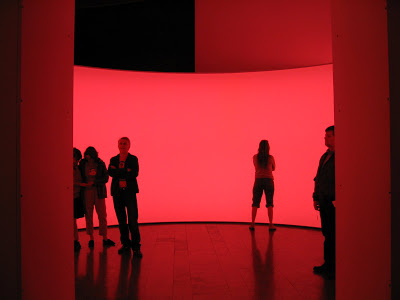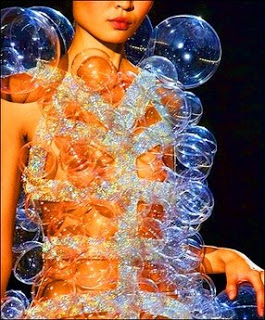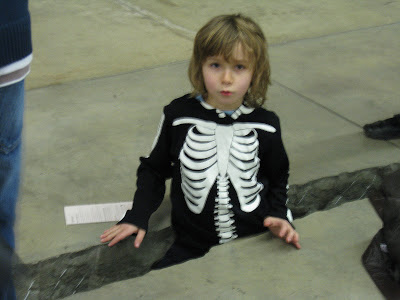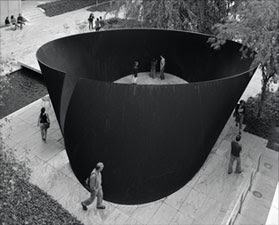Art rhetoric
Art Vent Letting the Fresh Air In
April 17, 2008

“The rainbow I see is not the rainbow you see”—rants about museum wall text and artists' statements come from a strong belief, derived initially from my study of Robert Irwin and his work, in the experience of art being unmediated and individual--that art which truly fulfills its purpose as art, requires no explanation. Olafur Eliasson, who I have also written about extensively, follows in Irwin’s footsteps and takes it one step further, viewing everything--from the publicity around an exhibition and the expectations it raises, to whatever personal interactions occur in the museum as well as the physical situation itself (including temperature, sound, and the presence of other people)--as contributing to the experience of the art. As he said yesterday at the press preview for his mid-career survey, which opens Sunday at MoMA and PS1: “I don’t want to interpret the work for you. My interpretation is not your interpretation.”
His pieces are not accompanied by wall text.
His pieces are not accompanied by wall text.
Comments (6)
April 6, 2008
Now selection of quotes from the Whitney Biennial p.r. --an example of true blogospherical collaboration:
 ...Thomson's inherently conversational practice both gamely Pop-ifies its often antiaesthetic historical precedents and resituates that generation's thought experiments in the social realm. (Suzanne Hudson on Mungo Thomson)
...Thomson's inherently conversational practice both gamely Pop-ifies its often antiaesthetic historical precedents and resituates that generation's thought experiments in the social realm. (Suzanne Hudson on Mungo Thomson)

 ...Thomson's inherently conversational practice both gamely Pop-ifies its often antiaesthetic historical precedents and resituates that generation's thought experiments in the social realm. (Suzanne Hudson on Mungo Thomson)
...Thomson's inherently conversational practice both gamely Pop-ifies its often antiaesthetic historical precedents and resituates that generation's thought experiments in the social realm. (Suzanne Hudson on Mungo Thomson) 
... Bove's "settings" draw on the style, and substance, of certain time-specific materials to resuscitate their referential possibilities, to pull them out of historical stasis and return them to active symbolic duty, where new adjacencies might reactivate latent meanings." (Jeffrey Kastner on Carol Bove)
April 4, 2008
The dialogue goes on in the comments on Catherine Spaeth’s post entitled "Being at Ease with Difficulty" where she takes issue with what she calls TIME critic Richard Lacayo’s (see yesterday's post) "call for censorship" :
Short of requiring by law that all wall texts be written in haiku—try cramming “problematize” into that little compartment—I’m not sure what can be done about this….Here might be a modest way to start. Let whoever edits museum catalogues—does anyone edit them?—ban just these five words, which are arranged into rhetorical daisy chains in every other catalogue I see.
1. Interrogates
2. Problematizes
3. References (as a verb)
4. Transgressive
5. Inverts
To those I would add “juxtaposition” and “informed” as in “his work is informed by…”
You are free to add your own.
Short of requiring by law that all wall texts be written in haiku—try cramming “problematize” into that little compartment—I’m not sure what can be done about this….Here might be a modest way to start. Let whoever edits museum catalogues—does anyone edit them?—ban just these five words, which are arranged into rhetorical daisy chains in every other catalogue I see.
1. Interrogates
2. Problematizes
3. References (as a verb)
4. Transgressive
5. Inverts
To those I would add “juxtaposition” and “informed” as in “his work is informed by…”
You are free to add your own.
April 3, 2008
On his my Tuesday post, which he found “funny/depressing”:
Why is so much curatorial writing so dreadful? Why is it so clogged with the decrepit formulations of academic artspeak? Why does so much of it sound like it was written by an anxious schoolkid delivering a labored term paper?
My first assumption is that there’s a generation of curators who went to college and grad school in the 1980s and ‘90s, when the congested language of Deconstruction, Critical Studies and so on still seemed important, intrepid, and even a little glamorous. I get the impression that even if a budding art writer wasn’t fully committed to those lines of inquiry, the incredibly turgid writing they produced infected the academy in all directions.
But the industrial strength rhetoric of so much museum writing is also, I suspect, a defense against anxiety by curators and catalogue essay writers afraid to simply say out loud and in plain English what they suppose the work might be getting at. What if they get it wrong? Better to fall back on clichés that stand in for thought without furthering it.
Finally bad writing is just insider talk. It’s not directed to the public at all, but pitched to the coterie of other curators and academics who use jargon to signal to one another their initiation into the world of…jargon.
Read complete article
Richard Lacayo in TIME on the Whitney Biennial
Why is so much curatorial writing so dreadful? Why is it so clogged with the decrepit formulations of academic artspeak? Why does so much of it sound like it was written by an anxious schoolkid delivering a labored term paper?
My first assumption is that there’s a generation of curators who went to college and grad school in the 1980s and ‘90s, when the congested language of Deconstruction, Critical Studies and so on still seemed important, intrepid, and even a little glamorous. I get the impression that even if a budding art writer wasn’t fully committed to those lines of inquiry, the incredibly turgid writing they produced infected the academy in all directions.
But the industrial strength rhetoric of so much museum writing is also, I suspect, a defense against anxiety by curators and catalogue essay writers afraid to simply say out loud and in plain English what they suppose the work might be getting at. What if they get it wrong? Better to fall back on clichés that stand in for thought without furthering it.
Finally bad writing is just insider talk. It’s not directed to the public at all, but pitched to the coterie of other curators and academics who use jargon to signal to one another their initiation into the world of…jargon.
Read complete article
Richard Lacayo in TIME on the Whitney Biennial
April 1, 2008
Trippy as the Whitney's prose is (see 3/28 post), I’m beginning to see that it opens up interesting linguistic possibilities in terms of new words or uses—such as as “Pop-ifies,” which seems to mean “makes like Pop art.” Now if you were to apply the ending to other art movements, such as Abstract Expressionism or Minimalism (Minimal-ifies? Minimalism-ifies?) it could get a little clunky—however I can see its literary applications. For instance, when we were talking about style at our Edward Winkleman said that a publication, having seen his blog, asked him to write something for them and then complained that it was too “bloggy.” Perhaps he should have Whitnified it a bit, just as the Whitney’s essays might have been improved with a little blogification.
Then there’s “spectatorial”--as in a “unified spectatorial vantage point” which I take to mean a “unified spectator vantage point” but with better clothes. However my absolute favorite is “problematizing” for which I can see myriad uses in the vernacular, and is certainly more concise than “making mountains out of mole hills.” You could say, “I had to leave the meeting because of all the problematizing that was going on” and everyone would know exactly what you meant. And don’t we all know people who are problematizers and never had a word for it? Or maybe I’ve just been in that interstitial space between understanding and confusion far too long.
Then there’s “spectatorial”--as in a “unified spectatorial vantage point” which I take to mean a “unified spectator vantage point” but with better clothes. However my absolute favorite is “problematizing” for which I can see myriad uses in the vernacular, and is certainly more concise than “making mountains out of mole hills.” You could say, “I had to leave the meeting because of all the problematizing that was going on” and everyone would know exactly what you meant. And don’t we all know people who are problematizers and never had a word for it? Or maybe I’ve just been in that interstitial space between understanding and confusion far too long.
March 28, 2008

Random quotes from the publicity information about the artists in the Whitney Biennial:
…It is the problematizing of expectations and formalisms through destruction and transformations that is the heart of the continuing project…. (Todd Alden on Mika Tajima/New Humans)
…It is the problematizing of expectations and formalisms through destruction and transformations that is the heart of the continuing project…. (Todd Alden on Mika Tajima/New Humans)
--------------------
…invents puzzles out of non sequiturs to seek congruence in seemingly incongruous situations, whether visual or spatial…inhabits those interstitial spaces between understanding and confusion… (Trinie Dalton on Amanda Ross-Ho)
…invents puzzles out of non sequiturs to seek congruence in seemingly incongruous situations, whether visual or spatial…inhabits those interstitial spaces between understanding and confusion… (Trinie Dalton on Amanda Ross-Ho)
--------------------
...Thomson's inherently conversational practice both gamely Pop-ifies its often antiaesthetic historical precedents and resituates that generation's thought experiments in the social realm. (Suzanne Hudson on Mungo Thomson)
--------------------
…features dozens of strips of junk mail spliced together and “stacked” in two zigzagging towers as if piled atop a desk: it is a conflation of art space and work space whose subtle allusion to the increasing corporatism of the art world is tempered by its intricate polychromatic delicacy…. (Lisa Turvey on Frances Stark)
…features dozens of strips of junk mail spliced together and “stacked” in two zigzagging towers as if piled atop a desk: it is a conflation of art space and work space whose subtle allusion to the increasing corporatism of the art world is tempered by its intricate polychromatic delicacy…. (Lisa Turvey on Frances Stark)
--------------------
... Bove's "settings" draw on the style, and substance, of certain time-specific materials to resuscitate their referential possibilities, to pull them out of historical stasis and return them to active symbolic duty, where new adjacencies might reactivate latent meanings." (Jeffrey Kastner on Carol Bove)
--------------------
…creates space for the articulation of intention….(Suzanne Hudson on MK Guth)
--------------------
…. This early work’s active impediment of a unified spectatorial vantage point has led the artist to investigate, in his words, “a variegated relationship between painting—a practice whose ossified discursive and speculative value I want to mark with its various economic and technical support systems—and the contradictions of discursive engagements that subsist largely outside the site of display, but which are value-producing sites nonetheless.”…. (Suzanne Hudson on Cheney Thompson)
--------------------
…acknowledges the elusiveness of her practice in a conversation … “There is this great movie title for a film with Leonardo DiCaprio called Catch Me If You Can…about a con artist who always manages to escape. All artists are sort of like con artists.” (Suzanne Hudson on Fia Backstrom)
--------------------
…creates space for the articulation of intention….(Suzanne Hudson on MK Guth)
--------------------
…. This early work’s active impediment of a unified spectatorial vantage point has led the artist to investigate, in his words, “a variegated relationship between painting—a practice whose ossified discursive and speculative value I want to mark with its various economic and technical support systems—and the contradictions of discursive engagements that subsist largely outside the site of display, but which are value-producing sites nonetheless.”…. (Suzanne Hudson on Cheney Thompson)
--------------------
…acknowledges the elusiveness of her practice in a conversation … “There is this great movie title for a film with Leonardo DiCaprio called Catch Me If You Can…about a con artist who always manages to escape. All artists are sort of like con artists.” (Suzanne Hudson on Fia Backstrom)
--------------------
The Whitney Biennial is inconsequential except in how it isolates, as Jerry Saltz put it, “the current art school moment” (he would know, having visited more art schools than just about anybody)—and therefore the ways in which such schools are failing would-be artists. The very homogeneity of the show is a tip-off. Instead of aiding students in finding their singular voices and helping them to develop the methods that best put them across (here I’m not referring necessarily to traditional art techniques--although they are part of the mix--but whatever vehicle allows an artist to reach his or her fullest expression) schools rarely teach skills outside of the mouthing of terms and art references. Hence the emphasis on what Saltz termed “Home Depot displays.” Not that great art can’t be inspired by the local hardware store—Dan Flavin did a pretty good job of it—but in this case, easily available, cheap materials attached to lofty ideas are taking the place of mastery. I read once that more people graduate from art school each year than made up the entire population of Florence during the Renaissance. When schools stay in business by convincing everyone that by investing a couple of years and many thousands of dollars they can become an artist, there’s no room for true critical evaluation.
The most succinct summing up so far comes from an Associated Press review with no byline in the Baltimore Sun, which also notes the “unmistakable art school feel”:
New art, even the most seemingly inscrutable, has the job of engaging with the culture around it, moving and affecting it in some way. Showcasing work that rehashes common themes and styles seems an odd path for a biennial to take. When the mundane fancies itself novel, it becomes nothing more than slightly irritating.
February 25, 2008

The installation at the Tate Modern (below), Doris Salcedo’s Shibboleth provides an excellent example of rhetoric standing in for, or justifying, the art. This is excerpted from the publicity material, which I suggest reading in toto just to get the full effect:
Salcedo is addressing a long legacy of racism and colonialism that underlies the modern world…” The history of racism,” Salcedo writes, “runs parallel to the history of modernity, and is its untold dark side”…. Our own time, Salcedo is keen to remind us, remains defined by the existence of a huge socially excluded underclass, in Western as well as post-colonial societies…”
Hullo, it’s a crack. A crack. A break in concrete. The artist’s intention does not change the experience, which happens to be one that leads to strange parental behavior. But if you insist on metaphor, it could represent any disparity—including the one between those who are willing to shell out $50 for a Duchamp T-shirt and those who aren’t.
February 19, 2008

Richard Serra from a video interview at MoMA on NewArtTV: “There isn’t any big paradigm shift. What happens is work comes out of work, and if the paradigm shift occurs, it’s because a problem leads to a different solution that you could not have anticipated.” Serra explains that he began his studio practice, not by plotting out specific pieces, but by asking himself questions such as: “What does it mean to build something that has a fixed joint?” “What does it mean to balance something?…to counterbalance something?” When asked by a journalist how he sees his future work at this point in his career, Serra repeats, “Work comes out of work. I don’t anticipate work to come….I just want to work.”
Ah, more support for my contention that art springs not from the “idea” or “concept” (see Back from VSC 2/1 and Talking the talk or…2/3 and the discussion in the Comments) that so many students are encouraged to have in place before they begin, but from the work itself and the questions it raises. The danger is that a “concept” can easily become a closed circuit—with the work remaining simply an illustration of that concept—whereas a “question” is an open one. This is not to say that there’s no place for analysis, but it’s a different activity, not to be mistaken for the art.
At its best, art produces responses that can’t be quantified—that are sensed rather than understood. So if we’re after something that can’t be understood, or an answer we didn’t anticipate, intellect won’t help us, only intuition—and the work, our process, is the stage we set to allow intuition to unfold.
Similarly, when talking or writing about their work, artists often give so much information, or information extraneous to the experience, that it interferes with the reaction to it and cuts off the possibility of responses they may not have anticipated—you can torture yourself with examples of this also on NewArtTV such as Diana Thater saying, “My work is about, for the most part, learning and knowing through observation that observation is knowledge or intense observation produces knowledge….” Does that make you crazy to see her work or what?
This is why, when I’m king, along with abolishing the artists’ statement, I’ll also regulate wall text, which I’ve noticed museum visitors spend more time with than the work itself. It’s not that information about an exhibition shouldn’t exist, but best relegated to a special room near the exit, one to which visitors can only gain entrance after proving that they’ve actually looked at what’s on display by taking a short quiz.